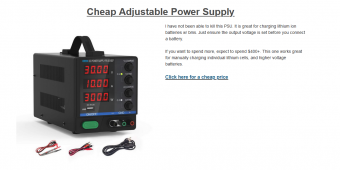@BretS - don't worry, it's a common mistake and for a one-off situation, not likely to lead to long-term damage.
You'll notice that Will uses much beefier supply to do his balance charging, so he can get up to 3.65v quickly and get the process over and done with. That's the key - don't spend a lot of time like days or weeks doing so.
What many miss without experience is disregarding the cumulative effects of TIME, and concentrating solely on voltages. Because that's immediately determined with a voltmeter and seems tangible to work with. TIME spent damaging your bank, especially if it is cumulative cycle-after-cycle isn't physically seen until later down the road.
So if it isn't seen right at the start, it doesn't exist.
So no worries. But had you come to me after buying that bank, I would have said "Did you also budget for a much larger charger supply to do this job that is at least capable of 0.2C at a minimum?
Long way of saying that you're good with this one-off event. But if you build another one and I catch you using a supply that is not at least 0.2C capable, well.....

You'll notice that Will uses much beefier supply to do his balance charging, so he can get up to 3.65v quickly and get the process over and done with. That's the key - don't spend a lot of time like days or weeks doing so.
What many miss without experience is disregarding the cumulative effects of TIME, and concentrating solely on voltages. Because that's immediately determined with a voltmeter and seems tangible to work with. TIME spent damaging your bank, especially if it is cumulative cycle-after-cycle isn't physically seen until later down the road.
So if it isn't seen right at the start, it doesn't exist.
So no worries. But had you come to me after buying that bank, I would have said "Did you also budget for a much larger charger supply to do this job that is at least capable of 0.2C at a minimum?
Long way of saying that you're good with this one-off event. But if you build another one and I catch you using a supply that is not at least 0.2C capable, well.....






